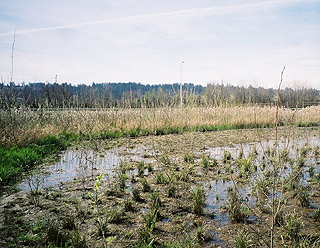
Surveys
DJC.COM
April 17, 2008
Easy steps to successful wetland mitigations
Raedeke Associates

Dietz
|

Wright
|
Nearly all development projects today require some amount of compensatory mitigation for impacts to wetlands and their buffers. Successful wetland mitigation may seem challenging and time-consuming — especially when federal, state and local agencies are involved — however, it can be accomplished with proper planning, timely maintenance and comprehensive monitoring.
Here are some tips to help you along the way.
Get the team together
Hire a reputable wetland consultant team to design your conceptual and final wetland mitigation plans. The conceptual mitigation plan gets your project through the site permitting process. It is during this stage that the various jurisdictions offer their input on your mitigation plan. The final mitigation plan includes the construction documents necessary for building permits, and serves as a basis for bids from landscape contractors.
The team should include a wetland scientist, a soil scientist and a landscape architect. Members contribute to the overall success of the mitigation project by bringing their specific expertise.
The team will help you carefully consider the location of the wetland mitigation project though a site assessment. Determining factors include soil types, surface and sub-surface drainage patterns, solar orientation, habitat types, existing vegetation, proposed storm water strategies and the project type.
Combine plants correctly

Photo courtesy of Raedeke Associates One of the keys to successful wetland mitigation is to monitor the survival rate of the plants. |
The conceptual and final mitigation plans will recommend native plant communities — not just a list of native plants. We have found that certain plant combinations are more successful in creating sustainable wetlands and buffers. The plans will also note the soil amendments and hydrological regimens needed to provide the foundation for the successful establishment of native plant communities.
Watch your site
It is imperative to have your wetland consultant team on-site during clearing, grading, and plant delivery and installation. If the site is not graded according to plans, costly revisions are often necessary and the potential success of the site can be compromised before a single plant is in the ground. Your landscape architect serves as your quality control expert by verifying appropriate plant species and correct plant numbers, as well as proper plant installation. It is much less expensive to do these steps once, correctly.
Hire experienced landscapers
We always recommend that a landscape contractor with specific experience in wetland mitigations be involved. They may seem initially more expensive but they are far less costly over time. Experienced landscapers know native plants and their unique requirements in wetland situations.
Ensure plant survival
Ensuring plant survival helps you get your performance bond back. Typical reasons for mitigation failure include: a lack of temporary irrigation during the first two growing seasons; small plants often require some sort of browse protection from wildlife; and invasive species such as reed canarygrass must be removed immediately or they will crowd out your plant investment. Waiting will only make future maintenance more expensive.
Monitor for the long run
We have found that a key to wetland mitigation success is long-term monitoring. Your wetland consultant can provide consistent, accurate and constructive long-term monitoring services, which are commonly required for a minimum of five years, sometimes 10 years, depending on the requirements of the local jurisdiction.
Some plants will die. Monitoring will note dead plants — which should be replaced immediately with the largest plants you can afford to help ensure meeting your performance criteria. It will also keep an eye out for invasive weeds, such as reed canarygrass and blackberry, which will need to be removed during the monitoring period.
It’s key to remember that you are legally required to make your wetland mitigation site succeed in order to get your bond back. Keep an eye on things over time; don’t plant it and forget it. And make your mitigation site both an ecological asset and an economic success.
Chris Wright has participated in more than 500 wetland projects. His experience includes all aspects of wetland management, from delineations to permitting to long-term mitigation monitoring. Duane Dietz, ASLA, LEED AP, is a licensed landscape architect with 18 years of experience. His work includes parks, playgrounds, wetland restoration, zoos, botanic gardens and historic preservation.
Other Stories:
- Landscape design inspiration beyond the office walls
- Seattle designer has a renaissance in North Dakota
- Are meadows the hot new landscape trend?
- Use a site analysis to value rural conservation lands
Copyright ©2009 Seattle Daily Journal and DJC.COM.
Comments? Questions? Contact us.